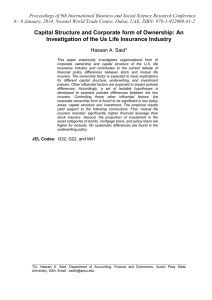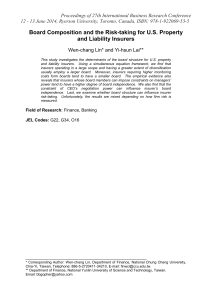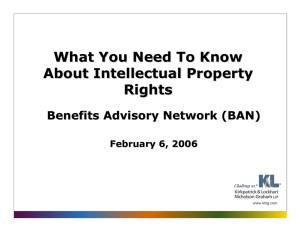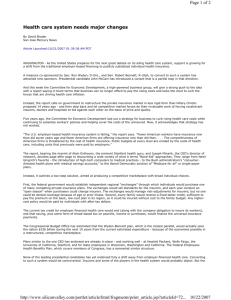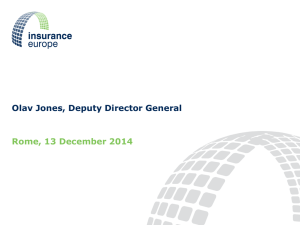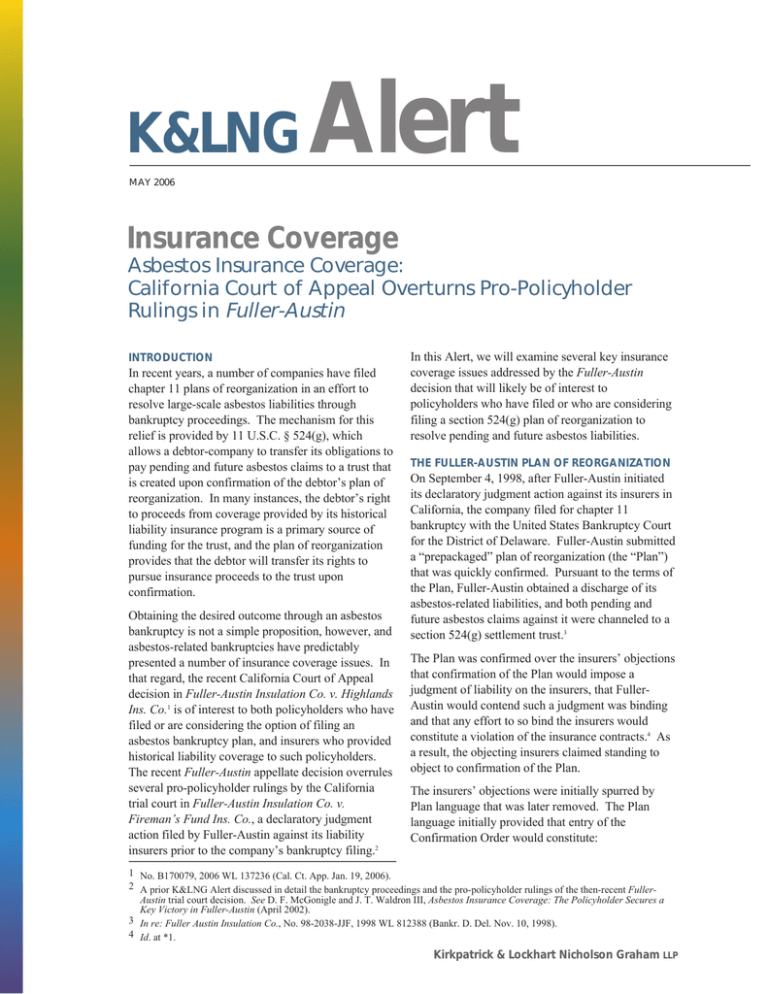
K&LNG
Alert
MAY 2006
Insurance Coverage
Asbestos Insurance Coverage:
California Court of Appeal Overturns Pro-Policyholder
Rulings in Fuller-Austin
INTRODUCTION
In recent years, a number of companies have filed
chapter 11 plans of reorganization in an effort to
resolve large-scale asbestos liabilities through
bankruptcy proceedings. The mechanism for this
relief is provided by 11 U.S.C. § 524(g), which
allows a debtor-company to transfer its obligations to
pay pending and future asbestos claims to a trust that
is created upon confirmation of the debtor’s plan of
reorganization. In many instances, the debtor’s right
to proceeds from coverage provided by its historical
liability insurance program is a primary source of
funding for the trust, and the plan of reorganization
provides that the debtor will transfer its rights to
pursue insurance proceeds to the trust upon
confirmation.
Obtaining the desired outcome through an asbestos
bankruptcy is not a simple proposition, however, and
asbestos-related bankruptcies have predictably
presented a number of insurance coverage issues. In
that regard, the recent California Court of Appeal
decision in Fuller-Austin Insulation Co. v. Highlands
Ins. Co.1 is of interest to both policyholders who have
filed or are considering the option of filing an
asbestos bankruptcy plan, and insurers who provided
historical liability coverage to such policyholders.
The recent Fuller-Austin appellate decision overrules
several pro-policyholder rulings by the California
trial court in Fuller-Austin Insulation Co. v.
Fireman’s Fund Ins. Co., a declaratory judgment
action filed by Fuller-Austin against its liability
insurers prior to the company’s bankruptcy filing.2
In this Alert, we will examine several key insurance
coverage issues addressed by the Fuller-Austin
decision that will likely be of interest to
policyholders who have filed or who are considering
filing a section 524(g) plan of reorganization to
resolve pending and future asbestos liabilities.
THE FULLER-AUSTIN PLAN OF REORGANIZATION
On September 4, 1998, after Fuller-Austin initiated
its declaratory judgment action against its insurers in
California, the company filed for chapter 11
bankruptcy with the United States Bankruptcy Court
for the District of Delaware. Fuller-Austin submitted
a “prepackaged” plan of reorganization (the “Plan”)
that was quickly confirmed. Pursuant to the terms of
the Plan, Fuller-Austin obtained a discharge of its
asbestos-related liabilities, and both pending and
future asbestos claims against it were channeled to a
section 524(g) settlement trust.3
The Plan was confirmed over the insurers’ objections
that confirmation of the Plan would impose a
judgment of liability on the insurers, that FullerAustin would contend such a judgment was binding
and that any effort to so bind the insurers would
constitute a violation of the insurance contracts.4 As
a result, the objecting insurers claimed standing to
object to confirmation of the Plan.
The insurers’ objections were initially spurred by
Plan language that was later removed. The Plan
language initially provided that entry of the
Confirmation Order would constitute:
1 No. B170079, 2006 WL 137236 (Cal. Ct. App. Jan. 19, 2006).
2 A prior K&LNG Alert discussed in detail the bankruptcy proceedings and the pro-policyholder rulings of the then-recent FullerAustin trial court decision. See D. F. McGonigle and J. T. Waldron III, Asbestos Insurance Coverage: The Policyholder Secures a
Key Victory in Fuller-Austin (April 2002).
3 In re: Fuller Austin Insulation Co., No. 98-2038-JJF, 1998 WL 812388 (Bankr. D. Del. Nov. 10, 1998).
4 Id. at *1.
Kirkpatrick & Lockhart Nicholson Graham LLP
“an adjudication of liability on the part of FullerAustin and the Trust for the Allowed Aggregate
Asbestos Claim and to holders of Asbestos
claims, and shall be a determination of a sum
that Fuller-Austin and the Trust shall be legally
obligated to pay . . . [A]n Asbestos Claim that is
Allowed shall constitute a judgment of liability
against Fuller-Austin and the Trust shall be
legally obligated to pay.”5
In view of the insurers’ objections, Fuller-Austin
amended the proposed Plan, adding a new provision
that provided for the maintenance of the California
declaratory judgment litigation and adjudication of
the claims and defenses of the objecting insurers in
that action.6
The Bankruptcy Court, relying on the amended
language, ruled that the rights of the objecting
insurers were preserved for adjudication in the
coverage litigation, and that the insurers therefore
lacked standing to object to Plan confirmation.7
THE CALIFORNIA TRIAL COURT RULING
In Fuller-Austin Insulation Co. v. Fireman’s Fund
Ins. Co., the California trial court ruled that
confirmation of the Plan constituted a “judgment”
that triggered the insurers’ payment obligations.8
In so holding, the trial court rejected the insurers’
argument that the bankruptcy proceedings did not
constitute an “actual trial” within the meaning of the
“no action” clause of the respective policies.9
Further, the court held that Fuller-Austin would be
allowed to establish and recover for “the present
liability [of Fuller-Austin] to pay pending and future
claims” and that the jury’s “reasonably proximate
estimation” of the value of such claims would be
binding on the insurers.10 In addition, the court held
that the insurers were required to provide coverage
for “Fuller-Austin’s entire legal obligation up to their
respective policy limits,” rather than limiting
coverage to amounts actually paid by Fuller-Austin,
as argued by the insurers.11 These holdings, among
others, set the stage for the subsequent appeal by
insurers and the recent appellate decision.12
FULLER-AUSTIN OVERRULED
The California Court of Appeal largely overruled the
decision of the trial court. Specifically, the court
overruled the trial court’s determinations: (i) that
confirmation of the Plan triggered the insurers’
payment obligations; (ii) that the jury’s estimation of
Fuller-Austin’s present and future claims could be
used to establish the amount of Fuller-Austin’s
liability; and (iii) that the insurers were obligated to
indemnify Fuller-Austin for the “allowed liquidated
value” of each claim, as opposed to payments
actually made by Fuller-Austin.
PLAN CONFIRMATION IS NOT AN “ACTUAL
TRIAL” TRIGGERING COVERAGE
First, the court rejected the trial court ruling that Plan
confirmation triggered the insurers’ payment
obligations and held that “[t]he trial court’s finding
that the confirmation proceedings amounted to an
actual trial is contrary to California law.”13
In support of its holding, the court reasoned that the
confirmation proceedings “contained none of the
attributes of an actual trial.”14 To that end, the court
noted that: (i) the confirmation hearing was not a
contested evidentiary hearing; (ii) the “evidence”
offered during the hearing did not address FullerAustin’s liability; (iii) the Plan was “the result of
negotiation – not fact-finding”; and (iv) “[t]he
bankruptcy court intentionally did not address the
Plan’s fairness to [the insurers].”15
5 Id. at *2.
6 The amended language provided as follows:
Maintenance of the Coverage Litigation. Notwithstanding any other provision in this Plan, all claims and defenses of any
Asbestos Insurance Company that is a party to the Coverage Litigation shall be adjudicated in the Coverage Litigation, and
all rights of the Asbestos Insurance Companies under the Asbestos Insurance Policies shall remain unaffected by the Plan
and the Confirmation Order.
Id. (emphasis in original).
7 Id. at *3.
8 Statement of Decision as to Phase IB, Issues 2-7 and 9, No. BC 116835, 2002 WL 31005090, at *20 (Cal. Super. Ct. Aug. 6, 2002).
9 Id. at *21 (“Even assuming that an ‘actual trial’ was a prerequisite to coverage, the Court finds that, as a matter of law, the
bankruptcy adjudication satisfies the . . . components of an ‘actual trial’ . . .”.).
10 Id. at *22-23 (citations omitted).
11 Id. In addition, the court held that Fuller-Austin’s “legal obligation” was equal to “at a minimum, the ‘allowed liquidated value.’”
Id. at *22.
12 For a further examination of the trial court rulings, and the implication of those rulings for coverage, see K&LNG’s prior Alert,
discussed at n.4 supra.
13 Fuller-Austin Insulation Co. v. Highlands Ins. Co., No. B170079, 2006 WL 137236, at *11 (Cal. Ct. App. Jan. 19, 2006).
14 Id. at *12.
15 Id.
2
Kirkpatrick & Lockhart Nicholson Graham
LLP
|
MAY 2006
The court summarized its holding as follows:
Fuller-Austin and the asbestos claimant
representatives had resolved all issues before
seeking confirmation, and [the insurers] did not
participate in prehearing negotiations and were
precluded from participating in the confirmation
hearing. Accordingly, the bankruptcy court
proceedings were not an “actual trial” within the
meaning of the insurance policies.16
PLAN CONFIRMATION PROCEEDINGS
CONSTITUTED A “SETTLEMENT”
Although the court held that confirmation is not an
actual trial triggering coverage, the court also held
that the confirmation proceedings constituted a
“settlement” that excess insurers were free to
challenge only on relatively narrow grounds.17 In so
holding, the court addressed the trial court’s findings
of fact and conclusions of law that, even if the
confirmation proceedings were not an “actual trial,”
Fuller-Austin was not required to obtain the insurers’
consent before settling with the asbestos claimants.18
In that regard, the court held that the Plan
confirmation proceedings constituted a settlement,
and that “substantial evidence supports the trial
court’s finding that [the insurers] were afforded a
reasonable opportunity to participate in the
settlement negotiations.”19 Accordingly, the court
further held that “[w]e do not believe that the policies
can be read to permit an excess insurer to hover in
the background of critical settlement negotiations
and thereafter resist all responsibility on the basis of
lack of consent.”20
Critically, however, the court also held that, although
the insurers could not “resist all responsibility,” the
insurers would be entitled to litigate the narrower
issue of “whether, as to them, the bankruptcy Plan is
unfair, unreasonable or the product of fraud or
collusion.”21 Thus, the court concluded that “[o]nce
raised and determined in this action, any findings on
the issues of the Plan’s fairness, reasonableness and
fraud or collusion will be binding on all asbestos
claims tendered to [the insurers] under their
policies.”22
ESTIMATION OF PRESENT AND FUTURE CLAIMS
CANNOT ESTABLISH AMOUNT OF LIABILITY
Second, the court held that “a state court jury’s
estimation of present and future claims cannot be
used to establish the amount of Fuller-Austin’s
liability,” reversing the trial court’s holding that the
jury’s valuation of Fuller-Austin’s liability to pay
pending and future claims would be binding on the
insurers.23
In so holding, the court rejected the trial court’s
reliance upon UNR Indus., Inc. v. Continental Ins.
Co.24 as the “centerpiece” of its aggregate valuation
analysis.25 Specifically, the court distinguished UNR
on the basis that the decision “relied on a bankruptcy
court valuation that was based on a finite sum . . .
used to settle identifiable asbestos claims” that “did
not [consider] claimants who had not yet been
identified,” as opposed to quantifying future and
unknown claim amounts.26
Accordingly, the court concluded that there is “no
authority . . . that would permit a jury to estimate the
aggregate sum of an insured’s liability for present
and potential future asbestos claims for the purpose
of accelerating its insurers’ obligations.”27
INSURERS OBLIGATED TO INDEMNIFY FULLERAUSTIN FOR ACTUAL PAYMENTS
Third, the court rejected the trial court ruling that the
insurers were obligated to indemnify Fuller-Austin
for its “entire legal obligation,” i.e., “at a minimum,
16 Id. at *13.
17 Id. at *19.
18 Fuller-Austin v. Fireman’s Fund, 2002 WL 31005090, at *23.
19 Fuller-Austin v. Highlands, 2006 WL 137236, at *15, 18.
20 Id. at *19.
21 Id. The court’s ruling on the insurers’ rights to challenge the Plan as a settlement involved a lengthy discussion and analysis of
Diamond Heights Homeowners Assn. v. Nat’l Am. Ins. Co., 277 Cal. Rptr. 906 (Cal. Ct. App. 1991). Diamond Heights addressed the
question of whether “excess insurers have the absolute right . . . to object to and therefore preclude any settlement which invaded
excess coverage, even if reasonable and made in good faith.” Id. at 915. The court in Diamond Heights concluded that “the excess
insurer does not have the absolute right to veto arbitrarily a reasonable settlement and force the primary insurer to proceed to trial,
bearing the full costs of defense.” Id. at 916. The court in Fuller-Austin held that the Diamond Heights rationale applied, and relied
upon that rationale as support for its holding that the insurers, on remand, may litigate the issue of whether the plan was unfair or
unreasonable to the insurers, or the product of fraud or collusion. Fuller-Austin, 2006 WL 137236, at *17-19.
22 Id. at *28.
23 Id. at *22.
24 942 F.2d 1101 (7th Cir. 1991). In UNR, the Seventh Circuit held that the UNR disclosure statement’s valuation of asbestos claims
was binding on CNA, one of UNR’s insurers. Id. at 1105-06.
25 Fuller-Austin, 2006 WL 137236, at *23.
26 Id. at *24.
27 Id. (citations omitted).
3
Kirkpatrick & Lockhart Nicholson Graham
LLP
|
MAY 2006
the ‘allowed liquidated value.’”28 Specifically, the
court held that “[the insurers] are not required to
indemnify Fuller-Austin in the [allowed liquidated
value] amount of each claim; their obligation is to
indemnify Fuller-Austin for the amount the Plan
obligates [Fuller-Austin] to pay for each allowed
claim.”29
In so holding, the court relied on a distinction
between Fuller-Austin’s payment obligation and the
“allowed liquidated value” under the terms of the
Plan. According to the court, the “allowed liquidated
value” in the Plan “serves only as a model of what
would be paid under the best case scenario,
assuming that the payment sum percentage reached
100 percent.”30 The court thus concluded that
because the “[allowed liquidated value] does not
reflect Fuller-Austin’s legal obligation to each
claimant,” that value “cannot be used as the basis for
fixing [the insurers’] indemnity obligations.”31
CONCLUSION
In sum, the recent Fuller-Austin decision is
significant for policyholders who have filed or are
considering filing an asbestos bankruptcy plan. The
court’s decision may provide a legal hurdle for
policyholders seeking to require insurers immediately
to provide coverage for the full amount of the
policyholder’s asbestos liabilities upon plan
confirmation. Further, the decision may spur
additional developments regarding the impact of plan
confirmation on insurers’ indemnity obligations and
debtor-policyholders’ rights to coverage.
Andrew R. Stanton
astanton@klng.com
412.355.6583
John T. Waldron, III
jwaldron@klng.com
412.355.8314
28 Fuller Austin v. Fireman’s Fund, 2002 WL 31005090, at *21-22.
29 Fuller-Austin v. Highlands, 2006 WL 137236, at *27.
30 Id. (emphasis added).
31 Id. (citations omitted).
If you have questions or would like more information about K&LNG’s Insurance Coverage Practice, please contact one of
our lawyers listed below.
International Contact
Boston
Dallas
Harrisburg
London
Los Angeles
Miami
Newark
New York
Pittsburgh
San Francisco
Washington
Peter J. Kalis
John M. Edwards
Paul E. Ridley
Carleton O. Strouss
Jane V. Harte-Lovelace
David P. Schack
Daniel A. Casey
Anthony P. La Rocco
Peter J. Kalis
Thomas M. Reiter
Edward P. Sangster
Matthew L. Jacobs
pkalis@klng.com
jedwards@klng.com
pridley@klng.com
cstrouss@klng.com
jharte-lovelace@klng.com
dschack@klng.com
dcasey@klng.com
alarocco@klng.com
pkalis@klng.com
treiter@klng.com
esangster@klng.com
mjacobs@klng.com
+1.412.355.6562
+1.617.261.3123
+1.214.939.4905
+1.717.231.4503
+44 (0) 20 7648 8172
+1.310.552.5061
+1.305.539.3324
+1.973.848.4014
+1.212.536.4828
+1.412.355.8274
+1.415.249.1028
+1.202.778.9393
Fax +1.412.355.6501
Fax +1.617.261.3175
Fax +1.214.939.4949
Fax +1.717.231.4501
Fax +44 (0) 20 7648 9001
Fax +1.310.552.5001
Fax +1.305.358.7095
Fax +1.973.848.4001
Fax +1.212.536.3901
Fax +1.412.355.6501
Fax +1.415.249.1001
Fax +1.202.778.9100
www.klng.com
BOSTON
n
DALLAS
n
HARRISBURG
n
LONDON
n
LOS ANGELES
n
MIAMI
n
NEWARK
n
NEW YORK
n
PALO ALTO
n
PITTSBURGH
n
SAN FRANCISCO
n
WASHINGTON
Kirkpatrick & Lockhart Nicholson Graham (K&LNG) has approximately 1,000 lawyers and represents entrepreneurs, growth and middle market companies, capital markets participants, and leading FORTUNE 100 and FTSE 100 global corporations nationally and internationally.
K&LNG is a combination of two limited liability partnerships, each named Kirkpatrick & Lockhart Nicholson Graham LLP, one qualified in Delaware,
U.S.A. and practicing from offices in Boston, Dallas, Harrisburg, Los Angeles, Miami, Newark, New York, Palo Alto, Pittsburgh, San Francisco and
Washington and one incorporated in England practicing from the London office.
This publication/newsletter is for informational purposes and does not contain or convey legal advice. The information herein should not be used or relied
upon in regard to any particular facts or circumstances without first consulting a lawyer.
Data Protection Act 1988—We may contact you from time to time with information on Kirkpatrick & Lockhart Nicholson Graham LLP seminars and with
our regular newsletters, which may be of interest to you. We will not provide your details to any third parties. Please e-mail cgregory@klng.com if you
would prefer not to receive this information.
© 2006 KIRKPATRICK & LOCKHART NICHOLSON GRAHAM LLP. ALL RIGHTS RESERVED.

